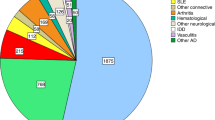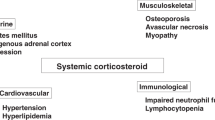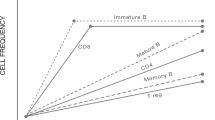Summary:
Hematopoietic stem cell transplantation (HSCT) for autoimmune diseases have been, because of safety reasons, overwhelmingly autologous. Results are, in general, encouraging with improvement in quality of life, a remission of up to several years, and perhaps in some diseases improved survival. This indicates that further study of autologous HSCT especially under phase III design is warranted. However, the ultimate goal of HSCT is cure of otherwise incurable autoimmune diseases. For this reason, allogeneic HSCT in carefully selected high-risk patients with autoimmune diseases using strategies to minimize both regimen-related toxicity and graft-versus-host disease (GVHD) is ongoing at Northwestern University and will be reviewed briefly.
This is a preview of subscription content, access via your institution
Access options
Subscribe to this journal
Receive 12 print issues and online access
$259.00 per year
only $21.58 per issue
Buy this article
- Purchase on Springer Link
- Instant access to full article PDF
Prices may be subject to local taxes which are calculated during checkout
Similar content being viewed by others
References
Hinterberger W, Hinterberger-Fischer M, Marmont AM . Clinically demonstrable anti-autoimmunity mediated by allogeneic immune cells favourably affects outcomes after stem cell transplantation in human autoimmune diseases. Bone Marrow Transplant 2002; 11: 753–759.
Slavin S, Nagler A, Varadi G, Or R . Graft vs autoimmunity following allogeneic non-myeloablative blood stem cell transplantation in a patient with chronic myelogenous leukaemia and severe psoriasis and psoriatic polyarthritis. Exp Hematol 2000; 28: 853–857.
Li H, Kaufman CL, Boggs SS et al. Mixed allogeneic chimerism induced by a sublethal approach prevents autoimmune diabetes and reverses insulitis in nonobese diabetic (NOD) mice. J Immunol 1996; 156: 380–388.
Wang B, Yamamoto Y, El-Badri NS, Good NA . Effective treatment of autoimmune disease and progressive renal disease by mixed bone-marrow transplantation that establishes a stable mixed chimerism in BXSB recipient mice. Proc Nat Acad Sci USA 1999; 96: 3012–3016.
Wang BY, Cherry, El-Badri NS, Good RA . Prevention of development of autoimmune disease in BXSB mice by mixed bone marrow transplantation. Proc Nat Acad Sci USA 1997; 94: 12065–12069.
Delaney CP, Murase N, Chen-Woan M et al. Allogeneic hematolymphoid microchimerism and prevention of autoimmune disease in the rat. A relationship between allo- and autoimmunity. J Clin Invest 1996; 97: 217–225.
Gaur LK, Kennedy E, Nitta Y et al. Induction of donor-specific tolerance to islet allografts in nonhuman primates. Ann NY Acad Sci 2002; 958: 194–198.
Wu T, Levay-Young B, Heuss N et al. Inducing tolerance to MHC-matched allogeneic islet grafts in diabetic NOD mice by simultaneous islet and bone marrow transplantation under nonirradiative and nonmyeloablative conditioning therapy. Transplantation 2002; 74: 22–27.
Wolfe F, Mitchell DM, Sibley JT et al. The mortality of rheumatoid arthritis. Arthrits Rheum 1994; 37: 481–494.
Erhardt CC, Mumford PA, Venables PJ, Maini RN . Factors predicting a poor life prognosis in rheumatoid arthritis: an eight-year prospective study. Ann Rheum Dis 1989; 48: 7–13.
Prior P, Symmons DPM, Scott DL et al. Cause of death in rheumatoid arthritis. Br J Rheumatol 1984; 23: 92–99.
Medsger TA, Masi AT, Rodnan GP et al. Survival with systemic sclerosis (scleroderma). Ann Intern Med 1971; 75: 369–376.
Wynn J, Fineberg N, Matzer L et al. Prediction of survival in progressive systemic sclerosis by multivariate analysis of clinical features. Am Heart J 1985; 110: 123–127.
Altman RD, Medsger Jr TA, Bloch DA, Michel BA . Predictors of survival in systemic sclerosis (scleroderma). Arthritis Rheum 1991; 34: 403–413.
Bryan C, Knight C, Black CM, Silman AJ . Prediction of five-year survival following presentation with scleroderma: development of a simple model using three disease factors at first visit. Arthritis Rheum 1999; 42: 2660–2667.
Kottaridis PD, Milligan DW, Chopra R et al. In vivo CAMPATH-1H prevents GvHD following nonmyeloablative stem-cell transplantation. Cytotherapy 2001; 3: 197–201.
Author information
Authors and Affiliations
Rights and permissions
About this article
Cite this article
Oyama, Y., Traynor, A., Barr, W. et al. Allogeneic stem cell transplantation for autoimmune diseases: nonmyeloablative conditioning regimens. Bone Marrow Transplant 32 (Suppl 1), S81–S83 (2003). https://doi.org/10.1038/sj.bmt.1703950
Published:
Issue Date:
DOI: https://doi.org/10.1038/sj.bmt.1703950
Keywords
This article is cited by
-
Hematopoietic stem cell transplantation and cellular therapies for autoimmune diseases: overview and future considerations from the Autoimmune Diseases Working Party (ADWP) of the European Society for Blood and Marrow Transplantation (EBMT)
Bone Marrow Transplantation (2022)
-
Cell Therapy of Refractory Crohn’s Disease
Bulletin of Experimental Biology and Medicine (2013)
-
Reduced-intensity allogeneic hematopoietic stem cell transplantation for acute leukemias: ‘what is the best recipe?’
Bone Marrow Transplantation (2005)
-
Significance of chimerism in hematopoietic stem cell transplantation: new variations on an old theme
Bone Marrow Transplantation (2004)



